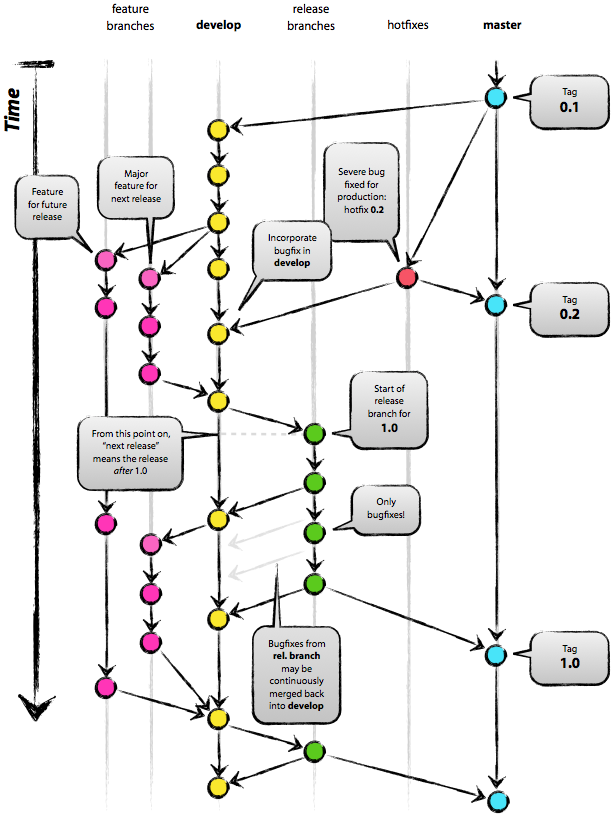[toc]
beego 是免费、开源的软件,这意味着任何人都可以为其开发和进步贡献力量。beego 源代码目前托管在 Github 上,Github 提供非常容易的途径 fork 项目和合并你的贡献。
::: tip beego 或许是我们走进云原生的第一步~
:::
架构图:
::: tip beego由四部分组成
- 基础模块:包括log模块、config模块、governor模块;
- Task:用于运行定时任务或周期性任务;
- 客户端:包括ORM模块、httplib模块、缓存模块;
- 服务器:包括网页模块。未来我们会支持gRPC;
:::
web应用程序:
beego 的安装是典型的 Go 安装包的形式:
go get github.com/astaxie/beego
常见问题:
-
git 没有安装,请自行安装不同平台的 git,如何安装请自行搜索。
-
git https 无法获取,请配置本地的 git,关闭 https 验证:
git config --global http.sslVerify false -
无法上网怎么安装 beego,目前没有好的办法,接下来我们会整理一个全包下载,每次发布正式版本都会提供这个全包下载,包含依赖包。
beego 升级分为 go 方式升级和源码下载升级:
-
Go 升级,通过该方式用户可以升级 beego 框架,强烈推荐该方式:
go get -u github.com/astaxie/beego -
源码下载升级,用户访问
https://github.com/astaxie/beego,下载源码,然后覆盖到$GOPATH/src/github.com/astaxie/beego目录,然后通过本地执行安装就可以升级了:go install github.com/astaxie/beego
beego 的 master 分支为相对稳定版本,dev 分支为开发者版本。大致流程如下:
mkdir hello
cd hello
go mod init
go get github.com/beego/beego/v2@latest
package main
import "github.com/beego/beego/v2/server/web"
func main() {
web.Run()
}go build hello.go
./hello
Go to http://localhost:8080
Congratulations! You've just built your first beego app.
bee 工具是一个为了协助快速开发 beego 项目而创建的项目,通过 bee 您可以很容易的进行 beego 项目的 创建、热编译、开发、测试、和部署 。
您可以通过如下的方式安装 bee 工具:
go get github.com/beego/bee安装完之后,bee 可执行文件默认存放在 $GOPATH/bin 里面,所以您需要把 $GOPATH/bin 添加到您的环境变量中,才可以进行下一步。
如何添加环境变量,请自行搜索 如果你本机设置了
GOBIN,那么上面的命令就会安装到GOBIN下,请添加 GOBIN 到你的环境变量中
我们在命令行输入 bee,可以看到帮助的信息
bee
bee version
new 命令是新建一个 Web 项目,我们在命令行下执行 bee new <项目名> 就可以创建一个新的项目。但是注意该命令必须在 $GOPATH/src 下执行。最后会在 $GOPATH/src 相应目录下生成如下目录结构的项目:
bee new myproject
[INFO] Creating application...
/gopath/src/myproject/
/gopath/src/myproject/conf/
/gopath/src/myproject/controllers/
/gopath/src/myproject/models/
/gopath/src/myproject/static/
/gopath/src/myproject/static/js/
/gopath/src/myproject/static/css/
/gopath/src/myproject/static/img/
/gopath/src/myproject/views/
/gopath/src/myproject/conf/app.conf
/gopath/src/myproject/controllers/default.go
/gopath/src/myproject/views/index.tpl
/gopath/src/myproject/main.go
13-11-25 09:50:39 [SUCC] New application successfully created!
myproject
├── conf
│ └── app.conf
├── controllers
│ └── default.go
├── main.go
├── models
├── routers
│ └── router.go
├── static
│ ├── css
│ ├── img
│ └── js
├── tests
│ └── default_test.go
└── views
└── index.tpl
8 directories, 4 files::: warning controllers
controllers里面内嵌了一个结构体,将 beego的controllers,基于此实现自己的 Get() 等…
package controllers
import (
"github.com/astaxie/beego"
)
type MainController struct {
beego.Controller
}
func (c *MainController) Get() {
c.Data["Website"] = "beego.me"
c.Data["Email"] = "[email protected]"
c.TplName = "index.tpl"
}不仅如此,或许我们可以添加自己的 Post()
func (c *MainController) Post() {
c.Data["Website"] = "beego.me"
c.Data["Email"] = "[email protected]"
c.TplName = "index.tpl"
}
func (c *MainController) Put() {
c.Ctx.WriteString("put")
}
func (c *MainController) Delete() {
c.Ctx.WriteString("delete")
}
func (c *MainController) Head() {
c.Ctx.WriteString("head")
}controller 逻辑:
package controllers
import (
"github.com/astaxie/beego"
)
type MainController struct {
beego.Controller
}
func (this *MainController) Get() {
this.Data["Website"] = "beego.me"
this.Data["Email"] = "[email protected]"
this.TplName = "index.tpl"
}1、声明了一个控制器 MainController,这个控制器里面内嵌了 beego.Controller,即Go 的嵌入方式,也就是 MainController 自动拥有了所有 beego.Controller 的方法。而 beego.Controller 拥有很多方法,其中包括 Init、Prepare、Post、Get、Delete、Head等方法。可以通过重写的方式来实现这些方法,以上例子重写了 Get 方法。
2、beego 是一个 RESTful 的框架,请求默认是执行对应 req.Method 的方法。例如浏览器的是 GET 请求,那么默认就会执行 MainController 下的 Get 方法。(用户可以改变这个行为,通过注册自定义的函数名)。
3、获取数据,赋值到 this.Data 中,这是一个用来存储输出数据的 map。
4、渲染模板,this.TplName 就是需要渲染的模板,这里指定了 index.tpl,如果用户不设置该参数,那么默认会去到模板目录的 Controller/<方法名>.tpl 查找,例如上面的方法会去 maincontroller/get.tpl(文件、文件夹必须小写)。用户设置了模板之后系统会自动的调用 Render 函数(这个函数是在 beego.Controller 中实现的),所以无需用户自己来调用渲染。
5、如果不使用模板可以直接输出:
func (this *MainController) Get() {
this.Ctx.WriteString("hello")
}:::
上面的 new 命令是用来新建 Web 项目,不过很多用户使用 beego 来开发 API 应用。所以这个 api 命令就是用来创建 API 应用的:
bee api apiproject这个项目的目录结构如下:
apiproject
├── conf
│ └── app.conf
├── controllers
│ └── object.go
│ └── user.go
├── docs
│ └── doc.go
├── main.go
├── models
│ └── object.go
│ └── user.go
├── routers
│ └── router.go
└── tests
└── default_test.go
从上面的目录我们可以看到和 Web 项目相比,少了 static 和 views 目录,多了一个 test 模块,用来做单元测试的。
同时,该命令还支持一些自定义参数自动连接数据库创建相关 model 和 controller: bee api [appname] [-tables=""] [-driver=mysql] [-conn="root:<password>@tcp(127.0.0.1:3306)/test"] 如果 conn 参数为空则创建一个示例项目,否则将基于链接信息链接数据库创建项目。
我们在开发 Go 项目的时候最大的问题是经常需要自己手动去编译再运行,bee run 命令是监控 beego 的项目,通过 fsnotify监控文件系统。但是注意该命令必须在 $GOPATH/src/appname 下执行。 这样我们在开发过程中就可以实时的看到项目修改之后的效果:
bee run我们打开浏览器就可以看到效果 http://localhost:8080/
::: warning bee run 做了什么
-
解析配置文件
beego 会自动解析在 conf 目录下面的配置文件
app.conf,通过修改配置文件相关的属性,我们可以定义:开启的端口,是否开启 session,应用名称等信息。 -
执行用户的hookfunc
beego会执行用户注册的hookfunc,默认的已经存在了注册mime,用户可以通过函数
AddAPPStartHook注册自己的启动函数。 -
是否开启 session
会根据上面配置文件的分析之后判断是否开启 session,如果开启的话就初始化全局的 session。
-
是否编译模板
beego 会在启动的时候根据配置把 views 目录下的所有模板进行预编译,然后存在 map 里面,这样可以有效的提高模板运行的效率,无需进行多次编译。
-
是否开启文档功能
根据EnableDocs配置判断是否开启内置的文档路由功能
-
是否启动管理模块
beego 目前做了一个很酷的模块,应用内监控模块,会在 8088 端口做一个内部监听,我们可以通过这个端口查询到 QPS、CPU、内存、GC、goroutine、thread 等统计信息。
-
监听服务端口
这是最后一步也就是我们看到的访问 8080 看到的网页端口,内部其实调用了
ListenAndServe,充分利用了 goroutine 的优势,一旦 run 起来之后,我们的服务就监听在两个端口了,一个服务端口 8080 作为对外服务,另一个 8088 端口实行对内监控。
:::
其他热加载:
::: tip
同样也有 air 等热加载工具。
:::
pack 目录用来发布应用的时候打包,会把项目打包成 zip 包,这样我们部署的时候直接把打包之后的项目上传,解压就可以部署了:
bee pack
我们可以看到目录下有如下的压缩文件:
-a--- 2022/11/21 16:56 16893719 beego.tar.gz用来压缩所有的静态文件变成一个变量申明文件,全部编译到二进制文件里面,用户发布的时候携带静态文件,包括 js、css、img 和 views。最后在启动运行时进行非覆盖式的自解压。
这个命令是用来自动化的生成代码的,包含了从数据库一键生成 model,还包含了 scaffold 的,通过这个命令,让大家开发代码不再慢
bee generate scaffold [scaffoldname] [-fields=""] [-driver=mysql] [-conn="root:@tcp(127.0.0.1:3306)/test"]
The generate scaffold command will do a number of things for you.
-fields: a list of table fields. Format: field:type, ...
-driver: [mysql | postgres | sqlite], the default is mysql
-conn: the connection string used by the driver, the default is root:@tcp(127.0.0.1:3306)/test
example: bee generate scaffold post -fields="title:string,body:text"
bee generate model [modelname] [-fields=""]
generate RESTful model based on fields
-fields: a list of table fields. Format: field:type, ...
bee generate controller [controllerfile]
generate RESTful controllers
bee generate view [viewpath]
generate CRUD view in viewpath
bee generate migration [migrationfile] [-fields=""]
generate migration file for making database schema update
-fields: a list of table fields. Format: field:type, ...
bee generate docs
generate swagger doc file
bee generate test [routerfile]
generate testcase
bee generate appcode [-tables=""] [-driver=mysql] [-conn="root:@tcp(127.0.0.1:3306)/test"] [-level=3]
generate appcode based on an existing database
-tables: a list of table names separated by ',', default is empty, indicating all tables
-driver: [mysql | postgres | sqlite], the default is mysql
-conn: the connection string used by the driver.
default for mysql: root:@tcp(127.0.0.1:3306)/test
default for postgres: postgres://postgres:[email protected]:5432/postgres
-level: [1 | 2 | 3], 1 = models; 2 = models,controllers; 3 = models,controllers,router这个命令是应用的数据库迁移命令,主要是用来每次应用升级,降级的SQL管理。
bee migrate [-driver=mysql] [-conn="root:@tcp(127.0.0.1:3306)/test"]
run all outstanding migrations
-driver: [mysql | postgresql | sqlite], the default is mysql
-conn: the connection string used by the driver, the default is root:@tcp(127.0.0.1:3306)/test
bee migrate rollback [-driver=mysql] [-conn="root:@tcp(127.0.0.1:3306)/test"]
rollback the last migration operation
-driver: [mysql | postgresql | sqlite], the default is mysql
-conn: the connection string used by the driver, the default is root:@tcp(127.0.0.1:3306)/test
bee migrate reset [-driver=mysql] [-conn="root:@tcp(127.0.0.1:3306)/test"]
rollback all migrations
-driver: [mysql | postgresql | sqlite], the default is mysql
-conn: the connection string used by the driver, the default is root:@tcp(127.0.0.1:3306)/test
bee migrate refresh [-driver=mysql] [-conn="root:@tcp(127.0.0.1:3306)/test"]
rollback all migrations and run them all again
-driver: [mysql | postgresql | sqlite], the default is mysql
-conn: the connection string used by the driver, the default is root:@tcp(127.0.0.1:3306)/test这个命令可以通过生成Dockerfile文件来实现docker化你的应用。
例子:
生成一个以1.9.2版本Go环境为基础镜像的Dockerfile,并暴露9000端口:
bee dockerize -image="library/golang:1.9.2" -expose=8080
更多帮助信息可执行bee help dockerize.
::: tip 打开 dockerfile 文件:
FROM library/golang:1.9.2
# Godep for vendoring
RUN go get github.com/tools/godep
# Recompile the standard library without CGO
RUN CGO_ENABLED=0 go install -a std
ENV APP_DIR $GOPATHD:\文档\最近的\awesome-golang\docs\code\beego
RUN mkdir -p $APP_DIR
# Set the entrypoint
ENTRYPOINT (cd $APP_DIR && ./D:\文档\最近的\awesome-golang\docs\code\beego)
ADD . $APP_DIR
# Compile the binary and statically link
RUN cd $APP_DIR && CGO_ENABLED=0 godep go build -ldflags '-d -w -s'
EXPOSE 8080:::
docker build -t mybeego:1.0 .
您可能已经注意到,在 bee 工具的源码目录下有一个 bee.json 文件,这个文件是针对 bee 工具的一些行为进行配置。该功能还未完全开发完成,不过其中的一些选项已经可以使用:
"version": 0:配置文件版本,用于对比是否发生不兼容的配置格式版本。"go_install": false:如果您的包均使用完整的导入路径(例如:github.com/user/repo/subpkg),则可以启用该选项来进行go install操作,加快构建操作。"watch_ext": []:用于监控其它类型的文件(默认只监控后缀为.go的文件)。"dir_structure":{}:如果您的目录名与默认的 MVC 架构的不同,则可以使用该选项进行修改。"cmd_args": []:如果您需要在每次启动时加入启动参数,则可以使用该选项。"envs": []:如果您需要在每次启动时设置临时环境变量参数,则可以使用该选项。
-
✴️版权声明 © :本书所有内容遵循CC-BY-SA 3.0协议(署名-相同方式共享)©


